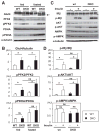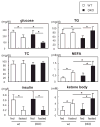Capillary endothelial fatty acid binding proteins 4 and 5 play a critical role in fatty acid uptake in heart and skeletal muscle
- PMID: 23968980
- PMCID: PMC3979458
- DOI: 10.1161/ATVBAHA.113.301588
Capillary endothelial fatty acid binding proteins 4 and 5 play a critical role in fatty acid uptake in heart and skeletal muscle
Abstract
Objective: Fatty acids (FAs) are the major substrate for energy production in the heart. Here, we hypothesize that capillary endothelial fatty acid binding protein 4 (FABP4) and FABP5 play an important role in providing sufficient FAs to the myocardium.
Approach and results: Both FABP4/5 were abundantly expressed in capillary endothelium in the heart and skeletal muscle. The uptake of a FA analogue, 125I-15-(p-iodophenyl)-3-(R,S)-methyl pentadecanoic acid, was significantly reduced in these tissues in double-knockout (DKO) mice for FABP4/5 compared with wild-type mice. In contrast, the uptake of a glucose analogue, 18F-fluorodeoxyglucose, was remarkably increased in DKO mice. The expression of transcripts for the oxidative catabolism of FAs was reduced during fasting, whereas transcripts for the glycolytic pathway were not altered in DKO hearts. Notably, metabolome analysis revealed that phosphocreatine and ADP levels were significantly lower in DKO hearts, whereas ATP content was kept at a normal level. The protein expression levels of the glucose transporter Glut4 and the phosphorylated form of phosphofructokinase-2 were increased in DKO hearts, whereas the phosphorylation of insulin receptor-β and Akt was comparable between wild-type and DKO hearts during fasting, suggesting that a dramatic increase in glucose usage during fasting is insulin independent and is at least partly attributed to the post-transcriptional and allosteric regulation of key proteins that regulate glucose uptake and glycolysis.
Conclusions: Capillary endothelial FABP4/5 are required for FA transport into FA-consuming tissues that include the heart. These findings identify FABP4/5 as promising targets for controlling the metabolism of energy substrates in FA-consuming organs that have muscle-type continuous capillary.
Keywords: capillaries; endothelial cells; fatty acid binding proteins; fatty acids; glucose; metabolism.
Figures






Similar articles
-
A critical role of fatty acid binding protein 4 and 5 (FABP4/5) in the systemic response to fasting.PLoS One. 2013 Nov 14;8(11):e79386. doi: 10.1371/journal.pone.0079386. eCollection 2013. PLoS One. 2013. PMID: 24244493 Free PMC article.
-
Exercise endurance capacity is markedly reduced due to impaired energy homeostasis during prolonged fasting in FABP4/5 deficient mice.BMC Physiol. 2019 Mar 13;19(1):1. doi: 10.1186/s12899-019-0038-6. BMC Physiol. 2019. PMID: 30866899 Free PMC article.
-
Robust suppression of cardiac energy catabolism with marked accumulation of energy substrates during lipopolysaccharide-induced cardiac dysfunction in mice.Metabolism. 2017 Dec;77:47-57. doi: 10.1016/j.metabol.2017.09.003. Epub 2017 Sep 20. Metabolism. 2017. PMID: 28941596
-
Imaging of cardiac metabolism using radiolabelled glucose, fatty acids and acetate.Coron Artery Dis. 2001 Feb;12 Suppl 1:S12-8. Coron Artery Dis. 2001. PMID: 11286301 Review.
-
Role of fatty acid uptake and fatty acid beta-oxidation in mediating insulin resistance in heart and skeletal muscle.Biochim Biophys Acta. 2010 Jan;1801(1):1-22. doi: 10.1016/j.bbalip.2009.09.014. Epub 2009 Sep 24. Biochim Biophys Acta. 2010. PMID: 19782765 Review.
Cited by
-
Identification of Diagnostic Biomarkers Associated with Stromal and Immune Cell Infiltration in Fatty Infiltration After Rotator Cuff Tear by Integrating Bioinformatic Analysis and Machine-Learning.Int J Gen Med. 2022 Feb 19;15:1805-1819. doi: 10.2147/IJGM.S354741. eCollection 2022. Int J Gen Med. 2022. PMID: 35221715 Free PMC article.
-
Modulation of endothelium function by fatty acids.Mol Cell Biochem. 2022 Jan;477(1):15-38. doi: 10.1007/s11010-021-04260-9. Epub 2021 Sep 16. Mol Cell Biochem. 2022. PMID: 34529222 Free PMC article. Review.
-
SCIG: Machine learning uncovers cell identity genes in single cells by genetic sequence codes.Nucleic Acids Res. 2025 May 22;53(10):gkaf431. doi: 10.1093/nar/gkaf431. Nucleic Acids Res. 2025. PMID: 40433981 Free PMC article.
-
CD36 is indispensable for thermogenesis under conditions of fasting and cold stress.Biochem Biophys Res Commun. 2015 Feb 20;457(4):520-5. doi: 10.1016/j.bbrc.2014.12.124. Epub 2015 Jan 13. Biochem Biophys Res Commun. 2015. PMID: 25596128 Free PMC article.
-
High-expression of FABP4 in Tubules is a Risk Factor for Poor Prognosis in DKD Patients.Curr Med Chem. 2024;31(22):3436-3446. doi: 10.2174/0109298673268265231228125431. Curr Med Chem. 2024. PMID: 38299395
References
-
- van der Vusse GJ. Albumin as fatty acid transporter. Drug Metab Pharmacokinet. 2009;24:300–307. - PubMed
-
- van der Vusse GJ, van Bilsen M, Glatz JF. Cardiac fatty acid uptake and transport in health and disease. Cardiovasc Res. 2000;45:279–293. - PubMed
-
- Hagberg CE, Falkevall A, Wang X, Larsson E, Huusko J, Nilsson I, et al. Vascular endothelial growth factor B controls endothelial fatty acid uptake. Nature. 2010;464:917–921. - PubMed
Publication types
MeSH terms
Substances
Grants and funding
LinkOut - more resources
Full Text Sources
Other Literature Sources
Medical
Molecular Biology Databases
Research Materials
Miscellaneous

